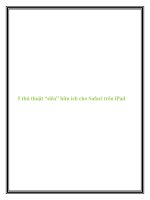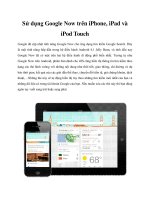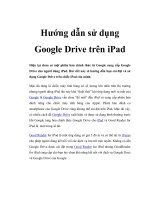iPad BasicsTonya Engst- P2A pot
Bạn đang xem bản rút gọn của tài liệu. Xem và tải ngay bản đầy đủ của tài liệu tại đây (588.54 KB, 5 trang )
11
More accurate location-finding is handy for using Maps and GPS
navigation apps, and for using the MobileMe-based Find My iPhone
service (which, despite the word “iPhone”, works with iPads).
Tip: Just like a mobile phone, the 3G iPad has a removable SIM
card that stores your cellular subscriber information. The iPad’s
tiny SIM card is a micro-SIM (3FF) card, so you can’t swap it out
for the larger-sized SIM cards used by most current devices and
network carriers (The new iPhone 4 also uses a micro-SIM card.)
There are some cons to the 3G iPad:
• Higher cost: You’ll pay $130 more for the iPad itself, and using
the 3G connection requires a paid data plan. In the United States,
AT&T offers two iPad data plans: one costs $14.99 a month for up
to 250 MB of data (upstream and downstream combined), and the
other costs $25 per month for 2 GB of data. You can monitor your
usage and switch plans easily whenever you want—there’s no long-
term contract. If you exceed the amount of data you’ve signed up for
within a 30-day billing cycle, you can buy a new 30-day plan—and
restart the clock—for either 250 MB 0r 2 GB for the same price.
If you are signed up for AT&T’s now-discontinued
unlimited $29.99 per month plan: You can remain on this
plan, but if you don’t keep it current, you can’t sign up for it again.
Rates for data plans in other countries vary.
• Bandwidth may disappoint: A con of using the Internet via
the cellular data network right now is slow data transfer, noticeably
slower than a good Wi-Fi connection. 3G connectivity is okay—but
not fabulous—for average Web browsing, but don’t depend on it for
watching streaming video or downloading big files. AT&T’s Web site
claims EDGE is fast enough for video and music, but my experience
in rural upstate New York with an iPhone would disagree. When
relying on EDGE reception, I’ve found that access times for apps
that go beyond basic text are almost untenable. On the other hand,
slow is better than nothing when you want to check the weather
quickly.
Download from Wow! eBook <www.wowebook.com>
12
The 3G iPad does have a number of benefits:
• Always-on connection: Unlike a Wi-Fi connection, a 3G con-
nection is likely to be available when you are out and about—in
locations like trains, parks, museums, and doctors’ offices. And, in
some cases where a Wi-Fi connection is available, it may cost you
$10 or so per day to access it, for instance at an airport or hotel.
For example: Give a kid a 3G iPad in the backseat during a car
trip and the 3G connection may stay up for hours. A Wi-Fi con-
nection won’t last long enough to make it worth figuring out how
to connect. (Unless the car has a mobile Wi-Fi hotspot, such as the
Dodge 2010 Grand Caravan; see
2010/grand_caravan/innovations/uconnect/.)
• Convenience: Connecting to cellular networks happens auto-
matically with no effort from you. You don’t have to tap anything
or enter a password. In contrast, connecting via Wi-Fi typically
requires you to tap your iPad’s screen a few times and enter a pass-
word, though you can set up the iPad to connect automatically to a
particular Wi-Fi network, a handy feature for quick connections at
home or work, or anywhere you visit often.
• Even more Wi-Fi: Your 3G data plan may include free Wi-Fi
access. For example, in the United States, AT&T’s iPad’s 3G service
plan includes free access to AT&T’s 20,000-plus Wi-Fi hotspots—
over half of which are at McDonald’s, allowing you to connect more
quickly via Wi-Fi at these hotspots. You can find AT&T hotspot
locations at
• Mapping: If you’ll be using the iPad as an on-the-go navigation
assistant for determining where you are and how to get where you
are going, whether with the built-in Maps app or a third-party GPS
navigation app, the 3G model will be vastly superior, especially with
an active data plan. The Wi-Fi iPad can use Wi-Fi positioning (just
like the iPod touch and original iPhone) to grab coordinates, but
that requires an active Wi-Fi connection to send and receive data.
The 3G iPad can determine its location using not only information
from Wi-Fi positioning, but also from its GPS chip and cell towers.
Also, the Find My iPhone service in MobileMe (which works with
iPads) provides far more exact coordinates for the 3G iPad.
Download from Wow! eBook <www.wowebook.com>
13
• Future planning: Even if you never need cellular connectivity, a
future user of your iPad might need it. A “future user” could be a
relative or friend who you give the iPad to, or it could be someone
you sell the iPad to.
Speaking for myself, I would have purchased a 3G iPad except that it
came out several weeks after the Wi-Fi iPad, and I needed my iPad
right away to write this ebook!
Storage Capacity
The iPad stores software and files using internal, non-upgradable flash
memory. You can choose 16, 32, or 64 GB of storage, and you’ll pay
another $100 for each doubling of capacity. Whether it’s worth more
money for more storage space depends on how you’ll use the iPad, now
and in the future.
Read Table 1 to get an idea of how much space you’re likely to want
for media, and spend a few minutes with a calculator to determine how
much space you might want for your files.
If you think you’ll want to put more media on your iPad, multiply using
the figure in the “Space Needed” column to predict how much room
you’ll want, keeping in mind that my estimates in this column are
based on likely typical use, but they may not exactly match your media.
Table 1 also includes the space needed by a few popular iPad apps.
Download from Wow! eBook <www.wowebook.com>
14
Table 1: How Many Gigabytes Do You Need?
To Store This
Space
Needed
Notes
Overhead and
system files
2.2 GB
iPhone OS 3.2. These files must be on
your iPad. You don’t get a choice.
100 songs
575 MB
128 Kbps AAC format.
100 photos
104 MB
380 MB on the Mac, automatically
resized/compressed during sync to
the iPad.
1 hour of standard
definition video from
the iTunes Store
750 MB
iTunes video wasn't compressed
further during sync. Other formats
may give different results.
10 Take Control
ebooks
30 MB
PDF format.
iBooks app
18 MB
Apple’s ebook-reading app. Ebooks
won’t take much additional space
unless they include a lot of graphics.
iWork apps
100 MB
Keynote, Pages, and Numbers.
Instapaper Pro app
3.9 MB
Displays on the iPad the text of Web
pages saved for later reading from
any computer Web browser.
Netflix app
3.2 MB
Streams video from Netflix.
Real Racing HD app
157 MB
A racing game controlled by tilting the
iPad.
Magic Piano app
9.4 MB
A multiplayer music app.
GoodReader for iPad
app
9 MB
Recommended for reading Take
Control ebook PDFs.
Most apps are under 10 MB in size and many are under 1 MB.
However, games can be large and navigation apps can be enormous.
Navigon MobileNavigator North America (not available as an iPad
app when this ebook was produced), for instance, is 1.46 GB in size.
To check an app’s size, view its catalog page in the App Store, which
you can access even if you don’t yet have an iPad through iTunes on
your computer.
Download from Wow! eBook <www.wowebook.com>
15
Note: You can figure that a gigabyte contains approximately 1,000
megabytes.
APPLECARE
You can purchase a $99 AppleCare extended warranty for your iPad.
It extends the hardware warranty from 1 year to 2 years, and it extends
the free phone support period from 90 days to 2 years. You can read
the details of what’s covered and how Apple will remedy a covered
problem in the PDF available here:
applecare/appforipad.html.
Reasons to pay $99 for AppleCare include:
• You think you’ll be a frequent caller to the phone support folks (but
ideally this ebook will reduce your need to call!).
• You’re worried about the battery. I don’t think you need to worry
much about the battery, but the AppleCare warranty offers a
replacement for any iPad that, within 2 years, can’t charge to more
than 50 percent of its original capacity. The regular warranty covers
just 1 year.
• You tend to be hard on electronic equipment, you know you’ll be
moving your iPad around a lot, or you expect it to be in especially
hot or cold temperatures.
Too cold? The iPad’s technical specs say you should use it
only down to 32° F (0° C), though it’s okay to store it down
to -4° F (-20° C). See
• You feel more comfortable with a warranty, especially on a first-
generation device that may be more likely to suffer odd problems.
• You may be able to sell an AppleCare-protected iPad for more
money.
I chose not to buy AppleCare, because $99 felt like too high a
proportion of the total cost of the device.
Download from Wow! eBook <www.wowebook.com>









